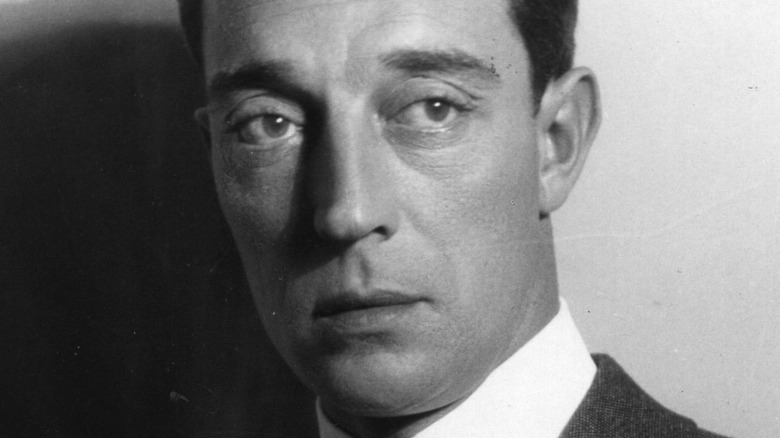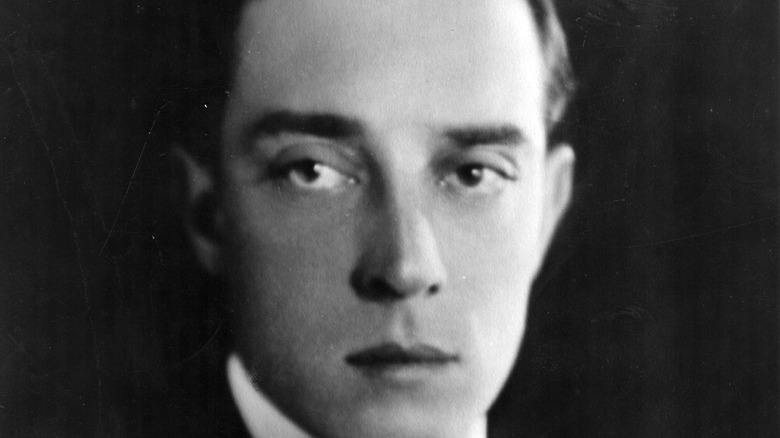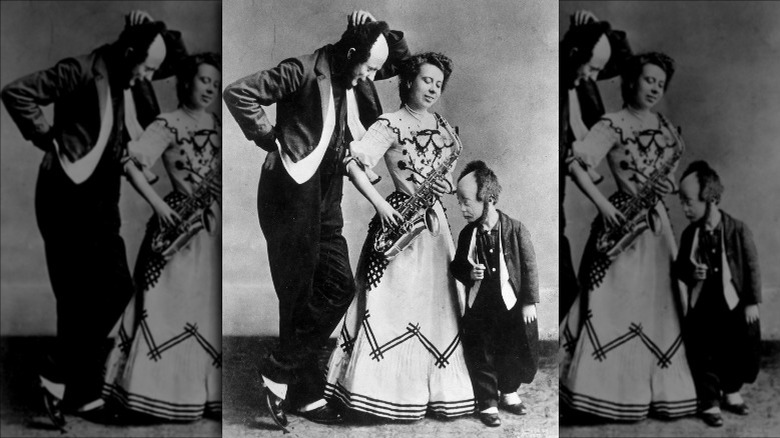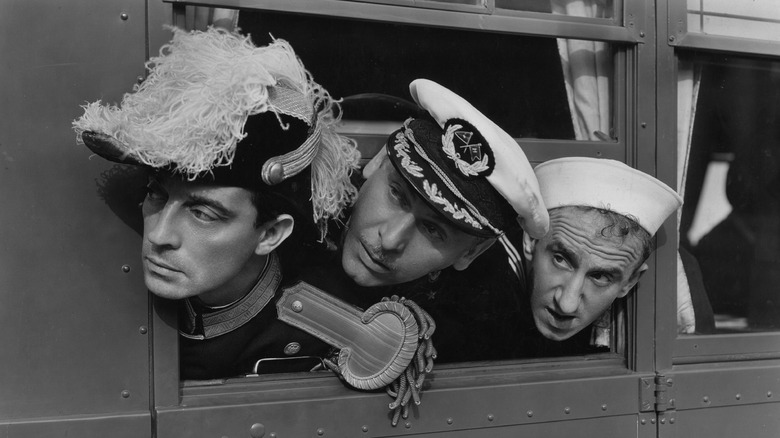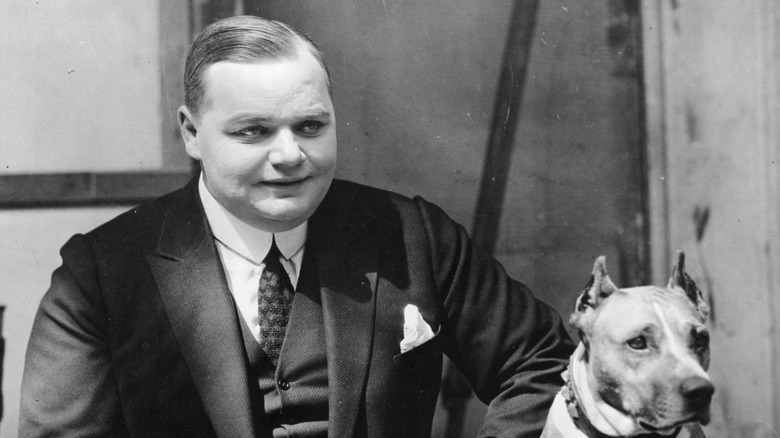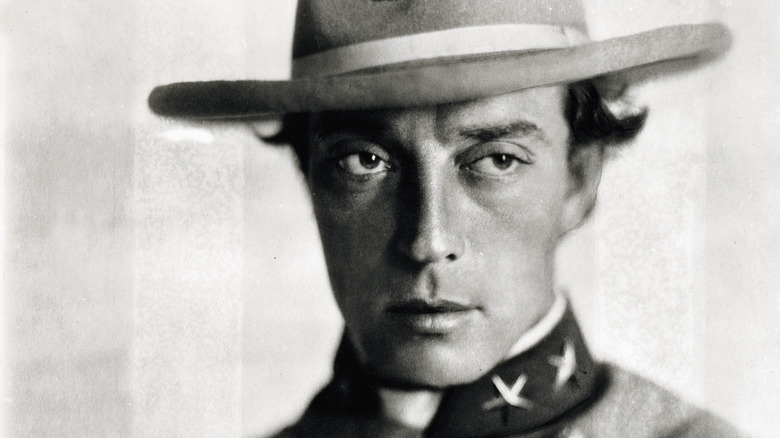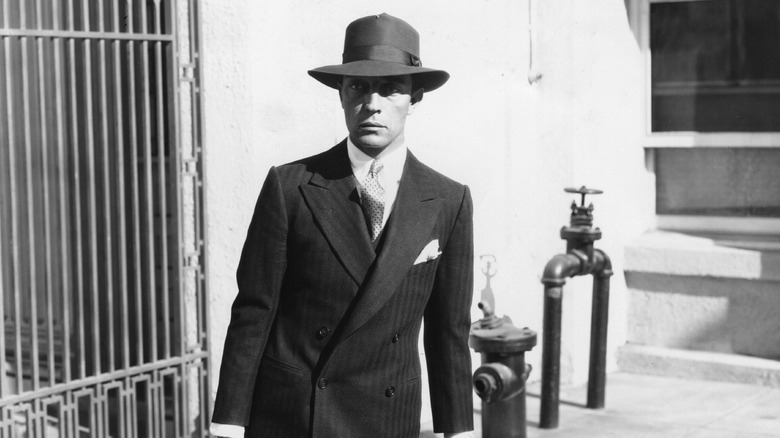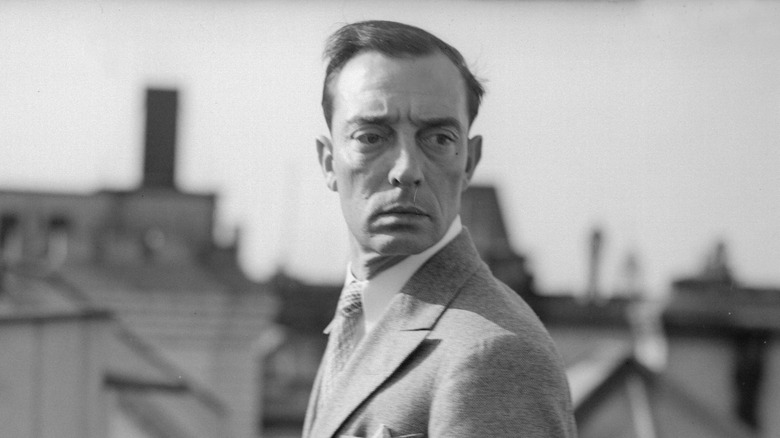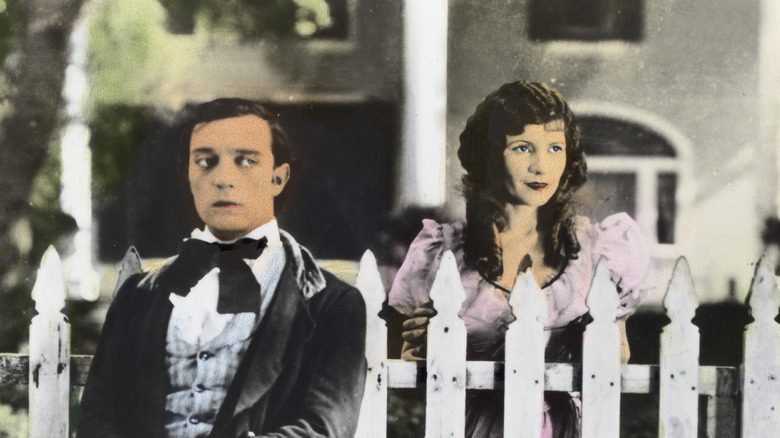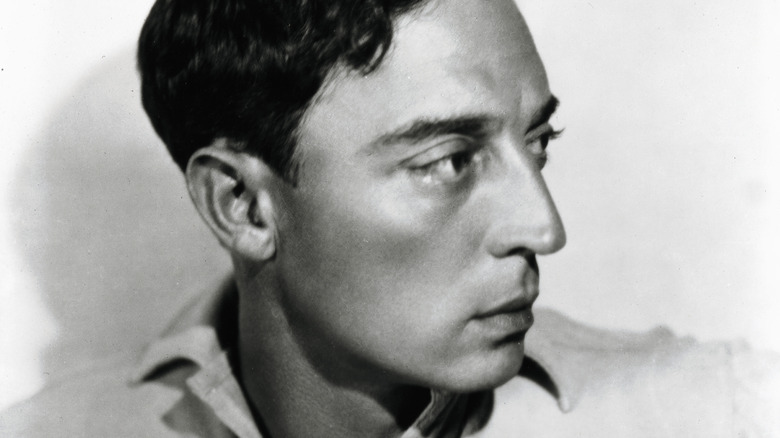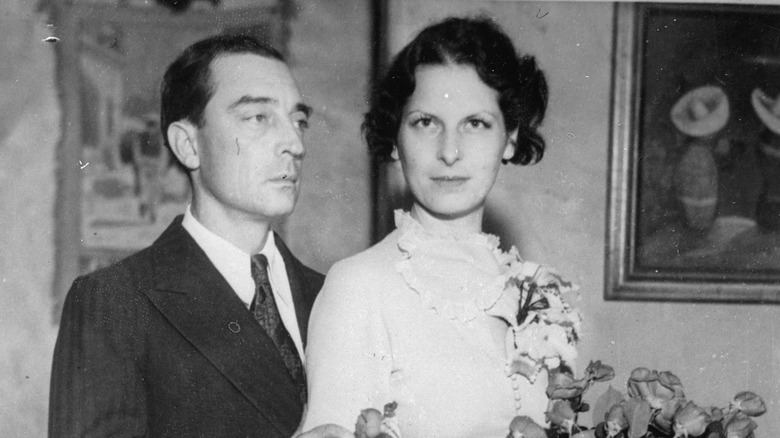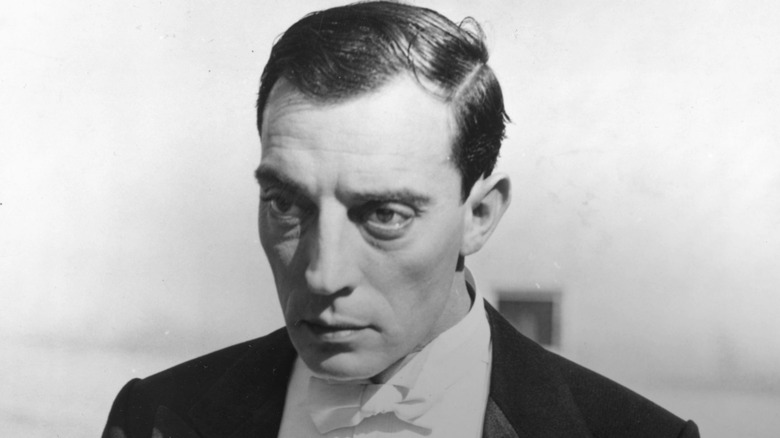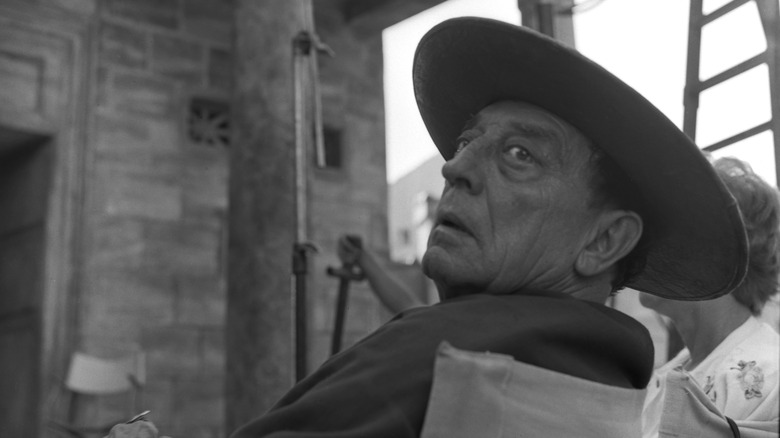The Tragic Real-Life Story Of Buster Keaton
Buster Keaton could delight audiences without uttering a single word. Keaton was born into an eccentric, acrobatic family, and slapstick comedy emerged as his clear calling. He also lent something to comedy that was previously unseen: a deadpan expression that earned him the nickname "The Great Stone Face." He integrated the expression into his work after noticing in his childhood that a serious expression got more laughs from audiences than a smiling one. But was the man behind that "Great Stone Face" as somber as he looked?
Yes and no. "I think I have had the happiest and luckiest of lives," Keaton said in his old age (via The New York Times). "Maybe this is because I never expected as much as I got. What I expected was hard knocks." After a dark period in the 1930s, Keaton managed to find happiness in his later years. Still, the film star experienced his fair share of hard knocks — literally. Here are a few notable ones.
Buster Keaton allegedly got his name after falling down a flight of stairs
Buster Keaton got his name in true slapstick fashion. As a baby, he tumbled all the way down a flight of stairs to the landing below. "Gee whiz," said George Pardey, an unknown Midwestern actor and a Keaton family friend, adding, "He's a regular buster!" The baby's father said, "I'm going to call him by it." And so little Joseph Frank Keaton became Buster Keaton.
According to Marion Meade's "Buster Keaton: Cut to the Chase: A Biography," the story has changed over the years. Buster's father, Joe, told the New York Dramatic Mirror that the incident happened when Buster was 18 months old, and credited Pardey for noting the baby was a "buster." In his autobiography, "My Wonderful World of Slapstick," Buster himself said he was just six months old and that it was Harry Houdini who christened him a "buster." Meade notes that Joe's story is more likely to be true, considering the Keaton family had not yet met Houdini when Buster was six months old.
Buster Keaton often found himself in dangerous circumstances as a child
Before Buster Keaton ever stepped foot on a stage, his days were full of calamities and dramas — not necessarily of the comedic variety. According to Marion Meade's "Buster Keaton: Cut to the Chase: A Biography," Keaton spent the first couple of years of his life sleeping in a suitcase, and sometimes in tents. His mother, Myra, once placed him in a costume trunk backstage while she and his father, Joe, performed vaudeville. A stagehand accidentally knocked the lid down, and Myra found Buster later, nearly suffocated. Joe and Myra tried tying him to poles backstage so he couldn't get into trouble. They tried feeding him booze to quiet him, and Joe even grew physically abusive at times.
According to the Buster Keaton website, when he was two years old, he got his finger caught in a clothes wringer and lost the first joint. That same day, he threw a brick at a peach tree and it ended up hitting him near his eye. The two-year-old Keaton once looked out of a window at a storm and was sucked into the violent vortex of a tornado, swirling until he was ultimately dropped in a field, according to Keaton and his parents. His worst injuries came from a train wreck.
Starting at age five, Keaton was performing onstage with his parents as his father threw him around in an act that was called "The Roughest Act That Was Ever in the History of the Stage."
If you or someone you know may be the victim of child abuse, please contact the Childhelp National Child Abuse Hotline at 1-800-4-A-Child (1-800-422-4453) or contact their live chat services.
Buster Keaton permanently damaged his hearing while fighting in WWI
Buster Keaton's first motion picture, "The Butcher Boy," came out two weeks before World War I began. According to Doughboy Center, he was drafted into the United States Army just as his career was kicking off. He arrived for training at California's Camp Kearney in July 1918 before being transferred to New York's Camp Mills. From there, Keaton and his fellow troops took a ship across the Atlantic, ending up at base camp in France.
"During my seven months as a soldier in France, I slept every night but one on the ground or on the floor of mills, barns and stables," Keaton recalled later (via Doughboy Center). "There is always a draft close to the floor of such farm buildings, and I soon developed a cold which imperiled my hearing. Before I was overseas a month, my superiors had to shout orders at me. I had become almost stone deaf due to my being exposed to floor drafts each night."
One night, Keaton was returning from playing a card game when one of his superiors challenged him to give a password. Keaton didn't hear the sentry or his warnings, so the sentry raised his gun in case Keaton was an intruder. "My life was saved by my sixth sense which enabled me to hear that gun click and stopped me dead in my tracks," Keaton said later. "From that day on, the fear of losing my hearing drove me half-crazy permanently." His hearing problems continued throughout his life.
Buster Keaton's close friend Roscoe 'Fatty' Arbuckle was accused of murder
"One day in September 1921, all of the laughter stopped," Buster Keaton once said, as quoted in David Yallop's "The Day The Laughter Stopped." "Overnight what had been innocent fun was suddenly being denounced as 'another Hollywood drunken orgy' or 'one more shocking example of sex depravity.' The day our laughter stopped was the day that Roscoe Arbuckle was accused of having caused the death of Virginia Rappe."
On September 5, 1921, actor Virginia Rappe, her manager Al Semnacher, and Semnacher's friend Maude Delmont went to a party at San Francisco's St. Francis Hotel. Rappe had been told that the silent film star Roscoe "Fatty" Arbuckle — Keaton's friend and frequent collaborator — would be there. What happened next is a mystery, but by the next morning, Rappe was lying on a bed in the hotel, crying out in pain, having difficulty urinating, and bleeding internally. She died a few days later.
Delmont publicly accused Arbuckle of sexually assaulting and killing Rappe, giving a lengthy account of events that was found to contain several lies. She was never called to the witness stand. Keaton publicly vouched for Arbuckle's character, and the jury apologized and acquitted Arbuckle, per Smithsonian. But the damage to his career was done. He changed his stage name to Will B. Goode, shifted to work behind the camera, and died of a heart attack a decade later.
'The General' received negative reviews and damaged Buster Keaton's career
If anyone was going to make a comedy movie about war, it was going to be Buster Keaton. So the former World War I troop, and lifelong whiz at excavating humor from disaster, made the 1926 movie "The General." The movie was about the Great Locomotive Chase of 1862, a train-centric military raid. Upon its release, "The General" was panned by critics, deemed a flop and some of his worst work to date. "Someone should have told Buster that it is difficult to derive laughter from the sight of men being killed in battle," Robert Sherwood wrote in Life magazine (via JSTOR Daily).
Considering Keaton had few real ties to the South, some were surprised that "The General" offered a Confederate-skewed revisionist history. Keaton was inspired by the similarly warped 1915 silent film "Birth of a Nation." Still, "The General" is now widely considered to be Keaton's greatest work. Director Orson Welles once deemed it "the greatest comedy ever made, the greatest Civil War film ever made, and perhaps the greatest film ever made" (via Open Culture).
Buster Keaton lost his creative freedom when he signed with MGM
In 1928, Buster Keaton's film collaborator and brother-in-law Joe Schenck convinced Keaton to move into the mainstream. So Keaton signed a deal with MGM which, according to Slate, brought him a salary of $3,000 per week, plus a significant percentage of profits from the films he made. Later, in his autobiography "My Wonderful World of Slapstick," Keaton would write about signing with MGM in a chapter titled "The Worst Mistake of My Life."
Some of Keaton's close friends warned him against taking the deal. "Don't do it," Keaton later quoted Charlie Chaplin as saying (via the Buster Keaton website). "They'll ruin you helping you. They'll warp your judgment. You'll get tired of arguing for things you know are right." But Schenck — and the pretty penny on offer — convinced Keaton otherwise. "It will be the same as though you were still working for me," Schenck assured him.
Pre-MGM, Keaton was an independent and largely improvisational filmmaker who worked on his own schedule and his own terms. With MGM, he had no choice but to follow a set studio schedule. He later said 22 writers workshopped the story for "The Cameraman," which knocked his confidence. In other words, Keaton began to realize that he had lost his creative freedom. "I don't know if it was human nature, greed, or power, but the big companies were out to kill the independents," he said later.
Buster Keaton was widely panned for his Columbia shorts
Between 1939 and 1941, Buster Keaton produced a series of shorts for Columbia. According to the New Review of Film and Television Studies, his approach was resurrecting old-timey slapstick style. He made $500 per short, and some of them only required a few days of shooting. The two-reelers were made in collaboration with "Three Stooges" director Jules White.
According to Variety, most of them saw Keaton "being slapped in the face, pricked in the bottom or hit on the head with heavy objects." They also leaned heavily on sound effects. "I think Jules White would be happy to just have anvils fall out of the sky and hit people," said Buster Keaton Society president Patricia Eliot Tobias.
Columbia shorts were some of the first projects Keaton worked on after his "comeback." Unfortunately, the shorts were widely and harshly criticized. According to the Columbia Shorts Department, Keaton himself agreed with the general consensus that the two-reelers were the worst pieces of work he'd ever been involved in.
Buster Keaton's first wife divorced him and received full custody of their children
On May 13, 1921, Buster Keaton married Natalie Talmadge, an actor who was one-third of the famous trio of Talmadge sisters. According to that day's Los Angeles Herald, the couple had a simple wedding in the Bayside neighborhood of Queens in New York City. The bride and groom, 24 and 25 years old at the time, were even rumored to be due to start collaborating on a film together. They went on to have two sons, Joseph "Jimmy" and Robert "Bobby," as noted in Imogen Sara Smith's "Buster Keaton: The Persistence of Comedy."
A decade later, on August 9, 1932, Talmadge testified in a divorce hearing against Keaton, citing neglect. She claimed he often stayed away at night, leaving her worrying at home. "My husband was impossible," Talmadge said during her testimony (via The Brooklyn Daily Eagle). "He would stay away from home, many times all night, and would not tell me where he had been. It upset me terribly. I could not sleep and would pace the floor for hours." The judge granted Talmadge a divorce, full custody of her and Keaton's two sons, and $300 a month in child support.
Buster Keaton went through a dark period of heavy drinking
In the midst of his troubles with MGM in the late 1920s and early 1930s, Buster Keaton began drinking alcohol excessively. According to the Buster Keaton website, he had been an enthusiastic social drinker during Prohibition, but now he was using alcohol to numb his misery, and with dire consequences. He experienced delirium tremens, a physical reaction to alcohol withdrawal, and was sent to a facility for treatment. There were a few years during which Keaton was drunk almost constantly.
According to JSTOR Daily, Keaton's father was an abusive alcoholic, and alcoholism can be an inherited trait. In a 1994 article for Film Quarterly, Judith Sanders and Daniel Lieberfeld wrote that Keaton "was able to express his hurt and anger only in cinematic disguises," and that alcohol served as his only other "emotional outlet."
Keaton quit drinking cold turkey in 1935, and after that, he only allowed himself one beer per evening and kept things under control. His excessive drinking appeared to be a phase that lasted a few dark years through the early 1930s.
If you or anyone you know is struggling with addiction issues, help is available. Visit the Substance Abuse and Mental Health Services Administration website or contact SAMHSA's National Helpline at 1-800-662-HELP (4357).
Buster Keaton's second wife divorced him
On January 8, 1933, Buster Keaton married a nurse named Mae Scrivens Hawley in Ensenada, Mexico, per The New York Times. His divorce from his first wife, Natalie Talmadge, was not yet finalized at the time. Once his divorce was finalized that October, he remarried Mae in California. Keaton had met Mae at Arrowhead Springs, where he was being treated for alcoholism and she administered "the right amounts of whiskey so I wouldn't go nuts and hypodermics to put me to sleep" (via Cabinet magazine). He reportedly married Mae as soon as he left the hospital.
Two years later, on July 17, 1935, Mae sued Buster Keaton for divorce. She also demanded $200,000 in damages from Leah Clampitt Sewell, a woman who was married to a rich yachtsman named Barton Sewell. Mae had allegedly found Keaton and Leah naked together in a Santa Barbara hotel room on the 4th of July. According to the El Paso Herald-Post, Mae accused Leah of "willfully and wrongfully" enticing Keaton's affections. Leah called the allegations associated with the lawsuit "ridiculous falsehoods."
Buster Keaton was briefly sent to a psychiatric ward
On October 23, 1935, Buster Keaton was admitted to the psychiatric ward of a hospital in Los Angeles, per a report in The Advocate at the time. He was reportedly in a "confused mental state" and "suffering from a complete nervous breakdown following a physical breakdown resulting from influenza."
The Advocate also noted that "it was necessary to transport him there in a straitjacket." The New York Times reported that Keaton was "locked" in the psychiatric ward. As noted by the Los Angeles Public Library, Keaton allegedly escaped from his straitjacket using wizardry he had learned from his family friend Harry Houdini when he was a child.
Factors including two divorces, a failed MGM deal, bankruptcy, and excessive use of alcohol contributed to Keaton's institutionalization. His state of mind was said to be caused by "financial and domestic troubles" (via The Advocate). Per The New York Times, Keaton's biographer Rudi Blesch said his troubles arose due to "the blackest of all the tragedies that can happen to an artist: the murder of his art."
If you or someone you know is struggling with mental health, please contact the Crisis Text Line by texting HOME to 741741, call the National Alliance on Mental Illness helpline at 1-800-950-NAMI (6264), or visit the National Institute of Mental Health website.
Buster Keaton died of lung cancer, which he thought was bronchitis
Two years before Buster Keaton's death, Penelope Gilliatt interviewed the star for a 1964 issue of The New Yorker. Gilliatt wrote that Keaton had bronchitis at the time. She also wrote that he had been invited to attend the premiere of the comedy movie "It's a Mad, Mad, Mad, Mad World," but that his wife, Eleanor, was advising him against it due to his illness and the possibility of a violent coughing fit. "We have aisle seats," Keaton said (via Scraps from the Loft). "You're not well," Eleanor said. "I can take my cough mixture," Keaton said. "I can take a small container. I can get ready to move in a hurry."
Keaton died of lung cancer on February 1, 1966. According to The New York Times, he died at home in Woodland Hills, a suburban neighborhood in Los Angeles. He was 70 years old. According to the Statesville Record and Landmark, Keaton's family had found out about the malignancy three months prior to Keaton's death, but did not tell him. It has been reported that Keaton believed he had mere bronchitis.
